Bettas don’t have to live alone. Many fish, snails, and shrimp can live peacefully with bettas in community tanks. The key is choosing the right betta fish tank mates and providing enough space. This guide covers the best betta tank mates, tank requirements, and how to create a successful community setup.
| Quick Reference | Key Information |
| Can Bettas Live With Others? | Yes, with proper tank mates and space |
| Minimum Tank Size | 10 gallons for community (20+ gallons better) |
| Best Tank Mates | Peaceful, non-flashy fish; snails; shrimp |
| Worst Tank Mates | Fin nippers, bright fish, aggressive species |
| Success Factor | Individual betta temperament varies greatly |
| Golden Rule | More space = better success rate |
Not all bettas accept tank mates. Some are peaceful and friendly. Others are aggressive and will attack anything that moves. You must watch your specific betta’s personality when adding betta fish companions. Finding compatible fish for bettas depends on individual temperament.
⚠️ Important Note: Every betta has a unique personality. What works for one betta may not work for another. Always have a backup plan to separate fish if aggression occurs. Monitor new additions closely for at least 48 hours.
Understanding Community Possibilities
The idea that bettas must live alone is outdated. Wild bettas live with other fish species in rice paddies and streams. Many domestic bettas can adapt to community life with proper setup.
Success depends on several factors. Your betta’s personality matters most. Some bettas are naturally peaceful and curious about other fish. These bettas explore their tank without aggression. Others are territorial and aggressive toward anything new.
Tank size makes or breaks community success. Small tanks create stress and fighting. Large tanks give everyone space to avoid each other. More space means less conflict and happier fish.
The species you choose matters tremendously. Peaceful, dull-colored fish work best. Bright, flashy fish trigger betta aggression. Long-finned fish look like rival bettas. Fast-swimming fish stress bettas. Bottom-dwellers avoid bettas naturally. Choosing non-aggressive fish for bettas ensures peaceful coexistence.
Water parameters must match for all species. Bettas need warm water around 78-80°F. Not all fish thrive at this temperature. Choose only fish that enjoy the same conditions. Mixing incompatible species causes stress and illness.
Feeding becomes more complex in community tanks. Bettas eat slowly at the surface. Fast fish steal food before bettas can eat. You need feeding strategies that ensure everyone gets enough food.
Space Requirements for Community Bettas
Tank size is the most critical factor for betta community success. Bigger is always better when mixing species. More space reduces aggression and stress dramatically. Understanding the minimum tank size for betta tank mates prevents common betta tank mate problems.
Minimum Tank Size: 10 Gallons This is the absolute minimum for adding any tank mates. A 10-gallon tank gives enough room for a betta plus small companions like snails or shrimp. Adding fish requires more space.
Ten gallons works for:
Recommended: 20 Gallons Twenty gallons is the sweet spot for betta communities. This size supports a betta plus a small school of peaceful fish. Everyone has space to swim and hide.
Twenty gallons works for:
Ideal: 30+ Gallons Larger tanks offer the best success rates. More water volume means more stable conditions. Fish can avoid each other easily. Aggression decreases significantly.
Thirty gallons and up works for:
Why Size Matters: Bettas are territorial fish. They claim areas as their own. In small tanks, the entire tank is betta territory. Other fish have nowhere to go. In large tanks, the betta claims part of the tank. Other fish live in different areas safely.
Think of it like sharing a room versus sharing a house. A small tank is like one room. Everyone is always too close. A large tank is like a house. You can have your own space when needed.
More water also dilutes waste better. Community tanks produce more waste than single-betta tanks. Larger volume handles this waste more easily. Water quality stays stable longer.
Proven Compatible Species
These species have the best track record with bettas. Each has been successfully kept with bettas in thousands of home aquariums. They’re peaceful, compatible, and generally safe betta tank mates. If you’re wondering what fish can live with bettas, this list covers the most reliable options.
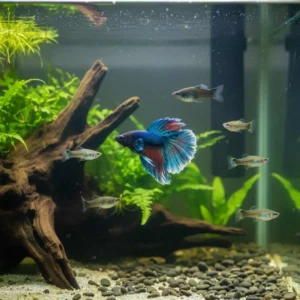
Colorful But Risky
Feeder guppies are plain, dull-colored guppies sold as food for larger fish. These work better with bettas than fancy guppies. Their plain appearance doesn’t trigger betta aggression as much.
Why They Work:
Tank Requirements: Minimum 20 gallons for betta and guppies. Keep groups of 5-6 guppies. They prefer some water flow.
Compatibility Rating: 60% success rate
Watch For: Male guppies have some color even as feeders. This can trigger betta aggression. Females are safer but less attractive. Some bettas attack any guppy regardless of color.
Guppies breed rapidly. You’ll soon have many babies. Betta will eat baby guppies. Control population or expect lots of fry.
Never use fancy guppies with long, colorful fins. Bettas see these as rivals. Aggression is almost guaranteed. Stick to plain feeder varieties only.
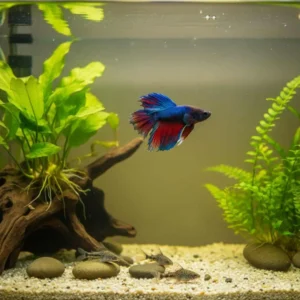
Peaceful Bottom Dwellers
Cory catfish are excellent betta companions. These small catfish stay at the tank bottom. They’re peaceful, active, and fun to watch. Multiple species exist in various sizes.
Why They Work:
Tank Requirements: Minimum 20 gallons for betta and corys. Keep groups of 4-6 corys. They need smooth substrate (sand is best) and hiding spots.
Compatibility Rating: 90% success rate
Watch For: Corys occasionally dart to the surface for air. This quick movement can startle bettas initially. Most bettas quickly get used to this behavior.
Feed corys sinking pellets or wafers. Make sure food reaches the bottom. Bettas won’t eat these foods so competition is minimal.
Popular species include Pygmy Corys (smallest), Panda Corys, and Bronze Corys. Smaller species work better in smaller tanks.
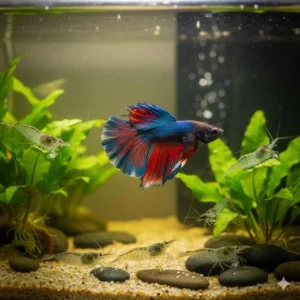
Active Little Cleaners
Ghost shrimp are small, clear shrimp that scavenge for food. They’re inexpensive and entertaining to watch. Many bettas coexist peacefully with these transparent critters.
Why They Work:
Tank Requirements: Minimum 10 gallons for betta plus shrimp. Keep groups of 5-10 shrimp. They need hiding spots like plants and decorations.
Compatibility Rating: 70% success rate
Watch For: Some bettas view shrimp as food. This is natural hunting behavior. If your betta constantly chases shrimp, separate them. Many new betta owners wonder “will my betta kill other fish?” With shrimp, the answer depends on hunting instincts. Baby shrimp will likely get eaten by any betta.
Ghost shrimp are more successful with peaceful bettas. Aggressive bettas often hunt them relentlessly. Start with a few shrimp to test your betta’s reaction before buying more.
Provide plenty of hiding spots. Live plants, driftwood, and decorations give shrimp safe areas. Well-planted tanks have much better success rates.
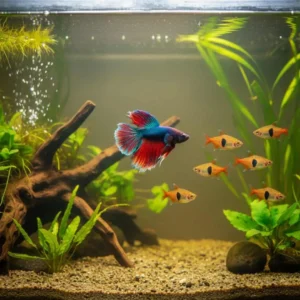
Ideal Schooling Fish
Harlequin rasboras are small, peaceful schooling fish. Their orange and black coloring is attractive but not threatening to bettas. They stay in the middle water column.
Why They Work:
Tank Requirements: Minimum 20 gallons for betta and rasboras. Keep schools of 6-10 fish. They prefer planted tanks with open swimming space.
Compatibility Rating: 85% success rate
Watch For: Schools need adequate numbers to feel secure. Fewer than 6 fish causes stress. Stressed fish swim erratically which can trigger betta interest.
Rasboras eat from the water column. Feed small floating or slow-sinking foods. Make sure your betta gets enough food since rasboras are faster eaters.
These fish are generally very safe with bettas. Aggression is rare. They’re often recommended as first tank mates for community bettas.
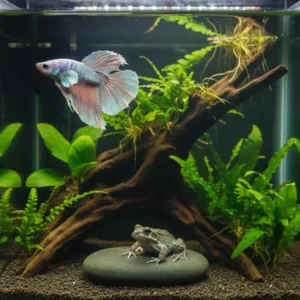
Unique Aquatic Companion
African dwarf frogs are fully aquatic frogs that live peacefully with bettas. They’re entertaining, unique, and completely different from fish. Many betta keepers love this combination.
Why They Work:
Tank Requirements: Minimum 10 gallons for betta and 1-2 frogs. They need smooth decorations (no sharp edges). Gentle or no filter flow preferred.
Compatibility Rating: 80% success rate
Watch For: Feeding can be tricky. Frogs have poor eyesight and eat slowly. Bettas often steal frog food. Use feeding tongs to give frogs food directly. Frozen bloodworms work well.
Frogs need to breathe air at the surface. They swim up regularly to gulp air. This is normal behavior. Ensure water level allows easy surface access.
Don’t confuse African Dwarf Frogs with African Clawed Frogs. Clawed frogs grow much larger and are aggressive. Only dwarf frogs work with bettas.
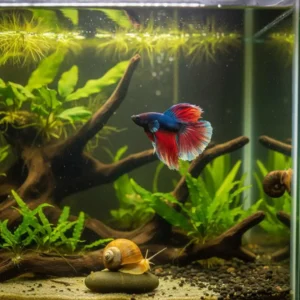
Peaceful Cleanup Crew
Mystery snails are perfect betta tank mates. These large, colorful snails mind their own business. Bettas usually ignore them completely. They come in gold, blue, purple, and ivory colors.
Why They Work:
Tank Requirements: Works in tanks as small as 5 gallons but 10+ gallons is better. Keep 1-3 snails per 10 gallons. They produce moderate waste.
Compatibility Rating: 95% success rate
Watch For: Occasionally, an aggressive betta might nip at snail antennae. If this happens, the snail retreats into its shell. Usually, the betta loses interest quickly. Severe cases may require separation.
Mystery snails need calcium for healthy shells. Feed snail-specific food occasionally. They eat algae, leftover fish food, and soft vegetables.
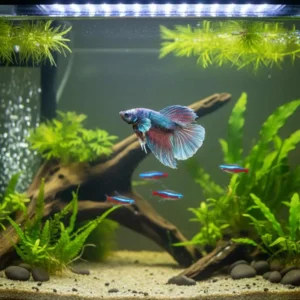
Classic Community Fish
Neon tetras are small, colorful schooling fish. Their blue and red striping is beautiful. They’re one of the most popular aquarium fish worldwide.
Why They Work:
Tank Requirements: Minimum 20 gallons for betta and neon tetras. Keep schools of 8-12 fish. They need stable water conditions and good filtration.
Compatibility Rating: 75% success rate
Watch For: Neon tetras are nippy occasionally. Some individuals nip at long betta fins. This betta nipping fins behavior is more common in small groups or stressed fish. Larger schools reduce this behavior. Watch for torn fins on your betta as a sign of nipping problems.
Neons prefer slightly cooler water (72-76°F) than bettas (78-80°F). The overlap at 76-78°F works for both. Keep temperature stable in this range.
Some bettas are aggressive toward neons because of their bright colors. Test compatibility carefully. Have a backup tank ready if needed.
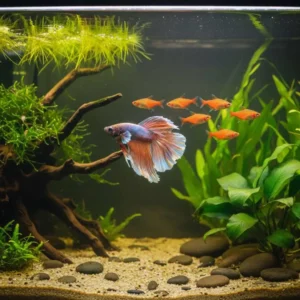
Tiny Orange Jewels
Ember tetras are tiny orange-red tetras. They’re smaller and less flashy than neon tetras. This makes them safer with bettas generally.
Why They Work:
Tank Requirements: Minimum 20 gallons for betta and ember tetras. Keep schools of 8-10 fish minimum. They need planted tanks with hiding spots.
Compatibility Rating: 80% success rate
Watch For: Ember tetras are very small. Large bettas might see tiny embers as food. This is rare but possible. Watch initial interactions closely.
These fish are more timid than other tetras. They need secure hiding spots. Heavily planted tanks work best. Open tanks stress them.
Ember tetras work better than neons with aggressive bettas. Their smaller size and calmer movement reduces betta interest.
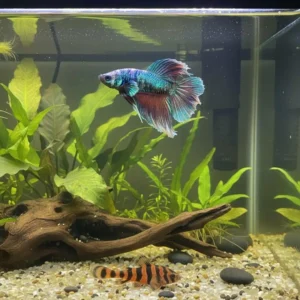
Peaceful Algae Eaters
Clown plecos are small plecostomus that stay under 4 inches. They’re peaceful algae eaters that hide during the day. Their wood-eating habit is unique and helpful.
Why They Work:
Tank Requirements: Minimum 20 gallons for betta and clown pleco. They need driftwood (they eat it), caves for hiding, and moderate flow.
Compatibility Rating: 85% success rate
Watch For: Clown plecos need driftwood in their diet. Provide natural driftwood pieces. They rasp the wood for nutrients. Without wood, they don’t thrive.
These plecos are shy and hide constantly. You might rarely see them. This is normal behavior. They emerge at night to eat.
Don’t confuse clown plecos with common plecos. Common plecos grow over 12 inches. They’re too large and active for betta tanks.

Eel-Like Bottom Dwellers
Kuhli loaches are snake-like fish that burrow in substrate. They’re peaceful, secretive, and completely ignore bettas. Their unique appearance is fascinating.
Why They Work:
Tank Requirements: Minimum 20 gallons for betta and kuhli loaches. Keep groups of 3-5 loaches. They need soft substrate (sand), hiding spots, and dim lighting.
Compatibility Rating: 90% success rate
Watch For: Kuhlis are escape artists. They squeeze through tiny gaps. Ensure your tank lid has no openings. Check equipment holes regularly.
These fish are very shy when first added. You might not see them for days. This is normal. They emerge once comfortable, especially at feeding time.
Kuhlis prefer groups. Single loaches hide constantly and are stressed. Groups of 3+ are more active and visible.

Living Plant Companion
Marimo moss balls aren’t fish or animals. They’re spherical algae that live in aquariums. Bettas love them and often rest on them.
Why They Work:
Tank Requirements: Works in any tank size. Add 1-3 balls per 10 gallons. They need light but not direct sun. Roll them occasionally to maintain shape.
Compatibility Rating: 100% success rate
Watch For: Moss balls occasionally float to the surface. This is normal. They release oxygen bubbles. Gently squeeze underwater to release bubbles. They’ll sink again.
Bettas often push moss balls around the tank. They rest on them like pillows. This interaction is adorable and harmless.
Clean moss balls monthly. Gently squeeze in old tank water. This removes debris. Return to tank immediately.
Special Considerations for Female Groups
Female betta sororities are groups of female bettas living together. This is different from keeping one male with other species. Sororities require special setup and understanding.
What is a Sorority? A betta sorority contains 4-6 female bettas minimum. Never keep just 2-3 females. Smaller groups result in bullying. Larger groups spread aggression among more fish.
Tank Requirements: Minimum 20 gallons for a small sorority. Thirty gallons is better. Forty gallons or larger gives best results. More space reduces fighting significantly.
Heavily planted tanks are mandatory. Every female needs hiding spots. Break up sight lines with plants and decorations. No female should see the whole tank at once.
Female Temperament: Female bettas are less aggressive than males. But they still establish hierarchies. The dominant female claims the best territory. Others submit or fight back.
Expect some chasing and displaying. Light aggression is normal during establishment. Serious fighting with torn fins requires intervention. Remove severely bullied individuals immediately.
Adding Tank Mates to Sororities: Sorority tanks can include other species. The same rules apply as with males. Peaceful, non-flashy species work best. More space is needed with multiple bettas.
Good sorority tank mates:
Avoid aggressive or nippy fish. The multiple bettas will gang up on problem fish. This creates more chaos than single-betta tanks.
Success Tips: Add all females simultaneously. This prevents territorial behavior toward late arrivals. Buy similar-sized females from the same tank if possible.
Provide multiple feeding areas. Use feeding rings or different tank zones. This prevents food aggression. Ensure every female eats adequately.
Watch for bullying daily. One dominant female sometimes terrorizes others. Remove the bully or rehome stressed victims. Not all females work in sororities.
Have backup tanks ready. Sororities sometimes fail despite good setup. Be prepared to separate aggressive individuals. This is common and not a failure on your part.
Choosing Compatible Species
Use this checklist before adding any tank mate to your betta’s tank. These factors determine success or failure.
Tank Size Requirements:
☐ Tank is at least 10 gallons (20+ gallons for fish)
☐ Tank is cycled with stable parameters
☐ Filtration is adequate for increased bioload
☐ Space for hiding spots and territories exists
Species Characteristics:
☐ Species is peaceful and non-aggressive
☐ Species doesn’t nip fins
☐ Species has dull or non-threatening colors
☐ Species lives in different water level than betta
☐ Species isn’t a bright red, blue, or has long fins
☐ Species is known as good tank mates for bettas
Water Requirements:
☐ Species prefers 76-80°F temperature
☐ Species tolerates betta water parameters
☐ Species has similar care difficulty
☐ Species isn’t sensitive or delicate
Your Betta’s Personality:
☐ Your betta is generally peaceful
☐ Your betta doesn’t flare at everything
☐ Your betta hasn’t shown extreme aggression
☐ Your betta isn’t overly territorial
☐ You’ve observed temperament for several weeks
Your Preparation:
☐ You have a backup/quarantine tank available
☐ You can return or rehome fish if needed
☐ You have extra hiding spots ready to add
☐ You’re prepared to monitor for 48+ hours
☐ You accept that it might not work
Red Flags to Avoid: If you’re researching what fish to avoid with bettas, this list covers the most dangerous combinations:
✗ Bright, colorful fish (gouramis, male guppies, other bettas)
✗ Long-finned fish (fancy guppies, angelfish)
✗ Known fin nippers (tiger barbs, serpae tetras)
✗ Large aggressive fish (cichlids, large gouramis)
✗ Fish that need cooler water (goldfish)
✗ Fast, active fish that stress bettas (danios)
Key Takeaways
Success with betta tank mates depends on these critical factors:
Tank Size Matters Most: Larger tanks have dramatically better success rates. Twenty gallons or more is ideal. Ten gallons is the absolute minimum for simple combinations like snails or shrimp.
Personality Varies: Every betta is different. Some accept tank mates easily. Others reject all companions. Test your betta’s temperament before committing to community setup.
Choose Wisely: Peaceful, dull-colored, bottom-dwelling species work best. Fish that can live with bettas include corys, rasboras, and certain tetras. Avoid bright, aggressive, or fin-nipping fish. When in doubt, choose the safer option.
Have Backup Plans: Not all combinations work. Be prepared to separate fish. Have quarantine or backup tanks ready. Don’t force incompatible fish to coexist.
Monitor Closely: Watch new additions for at least 48 hours. Look for chasing, nipping, or stress. Intervene quickly if problems emerge. Early separation prevents serious injury.
Start Small: Begin with one safe species like snails. Observe success before adding more. Building communities slowly reduces risk and stress.
Important Reminder: Betta aggression is natural behavior, not a flaw. If your betta rejects tank mates, that’s okay. Single-betta tanks are perfectly fine. Many bettas live happy, healthy lives alone. Don’t feel pressured to create community tanks if your betta prefers solitude.
Can I keep two male bettas together?
No, never keep two male bettas together. Males fight viciously, often to the death. This is true even in large tanks with lots of hiding spots. Male bettas are hardwired to fight other males. They cannot coexist peacefully ever. Keep only one male betta per tank always.
Will my betta eat shrimp?
Some bettas eat shrimp, others ignore them completely. It depends on your individual betta’s personality and hunting instincts. Ghost shrimp are more likely to be eaten than larger shrimp like Amano shrimp. Test with a few inexpensive shrimp first. Baby shrimp will almost always get eaten.
How do I know if my betta is too aggressive for tank mates?
Aggressive bettas flare constantly at their reflection, attack decorations, and seem hyperactive. They charge at the glass when you approach. If your betta shows these behaviors regularly, tank mates probably won’t work. Calm bettas that explore peacefully are better candidates for community life.
Can bettas live with goldfish?
No, bettas and goldfish are completely incompatible. Goldfish need cold water (65-72°F) while bettas need warm water (78-80°F). Goldfish also produce massive waste that pollutes water quickly. They grow large and can harm bettas. Keep these species completely separate always.
What should I do if my betta attacks a tank mate?
Remove the attacked fish immediately to a separate tank. Assess the damage – torn fins or injuries need clean water and possibly medication. Don’t return the fish to the betta tank. Either keep them separated permanently or rehome the attacked fish. Aggression usually doesn’t improve over time.
Bettas can live successfully with other fish, snails, and shrimp in proper setups. The key is choosing peaceful species, providing adequate space, and matching your betta’s personality to compatible tank mates.
Remember that every betta is unique. What works for other betta keepers might not work for yours. Some bettas thrive in communities. Others prefer living alone. Both situations are perfectly normal and healthy.
Start with safe species like mystery snails or cory catfish. Test compatibility slowly. Monitor interactions closely. Have backup plans ready. Building successful betta communities takes patience and observation.
Don’t feel disappointed if your betta rejects all tank mates. Many bettas prefer solitude. Single-betta tanks can be just as beautiful and interesting as communities. Your betta’s happiness and safety matter more than having multiple species.
If community tanks work for your betta, enjoy the diversity. Watch different species interact. Create a thriving mini-ecosystem. The reward of a peaceful betta community is worth the careful planning and preparation.